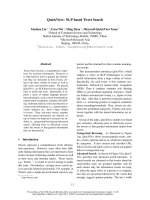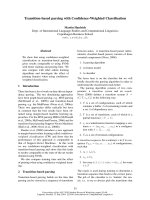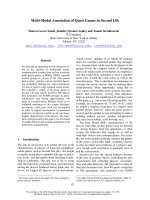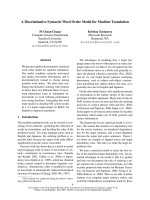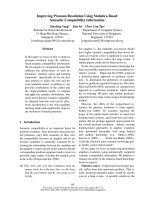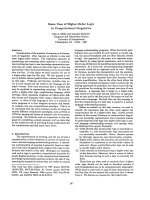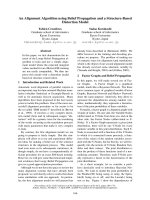Báo cáo khoa học: "ADP based Search Using Monotone Alignments in Statistical Translation" pdf
Bạn đang xem bản rút gọn của tài liệu. Xem và tải ngay bản đầy đủ của tài liệu tại đây (582.37 KB, 8 trang )
A DP based Search Using Monotone
Alignments in Statistical Translation
C. Tillmann, S. Vogel, H. Ney, A.
Zubiaga
Lehrstuhl f/Jr Informa,tik VI, RWTH Aachen
D-52056 Aachen, Germany
{t illmann, ney}©informatik, rwth-aachen, de
Abstract
In this paper, we describe a Dynamic Pro-
gramming (DP) based search algorithm
for statistical translation and present ex-
perimental results. The statistical trans-
lation uses two sources of information: a
translation model and a language mod-
el. The language model used is a stan-
dard bigram model. For the transla-
tion lnodel, the alignment probabilities are
made dependent on the differences in the
alignment positions rather than on the
absolute positions. Thus, the approach
amounts to a first-order Hidden Markov
model (HMM) as they are used successful-
ly in speech recognition for the time align-
ment problem. Under the assumption that
the alignment is monotone with respect to
the word order in both languages, an ef-
ficient search strategy for translation can
be formulated. The details of the search
algorithm are described. Experiments on
the EuTrans corpus produced a word error
rate of 5.1(/~
1 Overview: The Statistical
Approach to Translation
The goal is the translation of a text given in some
source language into a target language. We are given
o J
a source ('French') string fl =
fl fj f.l,
which
is to be translated into a target ('English') string
c~ = el ei el.
Among all possible target strings,
we will choose the one with the highest probability
which is given by Bayes' decision rule (Brown
et
al
1993):
,~
=
argmax{P,'(e]~lfg~)}
= argmax {P,'(ef).
Pr(.f/lef)}
Pr(e{)
is the language model of the target language.
whereas
Pr(j'lale{)
is the string translation model.
The argmax operation denotes the search problem.
In this paper, we address
• the problem of introducing structures into the
probabilistic dependencies in order to model
the string translation probability
Pr(f] [e~).
• the search procedure, i.e. an algorithm to per-
form the argmax operation in an efficient way.
• transformation steps for both the source and
the target languages in order to improve the
translation process.
The transformations are very much dependent on
the language pair and the specific translation task
and are therefore discussed in the context of the task
description. We have to keep in mind that in the
search procedure both the language and the transla-
tion model are applied
after
the text transformation
steps. However, to keep the notation simple we will
not make this explicit distinction in the subsequent
exposition. The overall architecture of the statistical
translation approach is summarized in Figure 1.
2 Aligmnent Models
A key issue in modeling the string translation prob-
ability
Pr(f(le I)
is the question of how we define
the correspondence between the words of the target
sentence and the words of the source sentence. In
typical cases, we can assume a sort of pairwise de-
pendence by considering all word pairs
(fj,ei)
for
a given sentence pair [f(; el]. We further constrain
this model by assigning each source word to
exact-
ly one
target word. Models describing these types
of dependencies are referred to as
alignrnen.t models
(Brown
et
al., 1993), (Dagan eta] 1993). (Kay &
R6scheisen, 1993). (Fung & Church. 1994), (Vogel
et al., 1996).
In this section, we introduce a monotoue HMM
based alignment and an associated DP based search
algorithm for translation. Another approach to sta-
tistical machine translation using DP was presented
in
(Wu,
1996). The notational convention will be a,s
follows. We use the symbol
Pr(.)
to denote general
289
Source Language Text
1
I Transformation
1
¢~
Global Search: j~
Lexicon Model
maximize Pr(el). pr(f~lell} I I AllgnmentModel
ovor j.
pc(e~) [ Language Model,
[; ,! ,,on]
1
Target Language Text
Figure I: Architecture of the translation approach
based on Bayes decision rule.
probability distributions with (nearly) no specific as-
snmptions. In contrast, for model-based probability
distributions, we use the generic symbol p(.).
2.1 Alignment with HMM
When aligning the words in parallel texts (for
Indo-European language pairs like Spanish-English,
German-English, halian-German ), we typically
observe a strong localization effect Figure 2 illus-
trates this effect, for the language pair
Spanish-to-
English.
In many cases, although not always, there
is an even stronger restriction: the difference in the
position index is smaller than 3 and the alignment.
is essentially monotone. To be more precise, the
sentences can be partitioned into a small number
of segments, within each of which the alignment is
monotone with respect to word order in both lan-
gaages.
To describe these word-by-word alignments, we
introduce the mapping
j o j,
which assigns a po-
sition j (with source word
.fj )
to the position i =
aj
(with target word ei). The concept of these align-
ments is similar to the ones introduced by (Brown
et al.,
1993), but we will use another type of de-
pendence in the probability distributions. Looking
at. such alignments produced by a human expert,
it,
is evident that the mathematical model should try
to capture the strong dependence of aj on the pre-
ceding alignment
a j-1.
Therefore the probability of
alignment aj for position j should have a dependence
on the previous alignment position
O j_l:
P((/j [(/j-1 )
A similar approach has been chosen by (Dagan et
al., 1993) and (Vogel et al 1996). Thus the problem
formulation is similar t.o that of/,he time alignment
problem in speech recognition, where the so-called
Hidden Markov models have been successfully used
for a long time (Jelinek. 1976). Using the same basic
principles, we can rewrite the probability by intro-
ducing the 'hidden" aligmnents a~ := a l aj aa for
a sentence pair [f~; c/]:
P,,(s 'lcI
=
J
~i'
j=1
To avoid any confnsion with the term
'hidden'in
comparison with speech recognition, we observe that
the model states as such (representing words) are
not
hidden but the actual alignments, i.e. the
sequence
of position index pairs (j. i =
aj ).
So far there has been no basic restriction of the
approach. We now assume a first-order dependence
on the alignments
aj
only:
Pr(fj,ajlf~-l,a{-1.e{) = p(fj,(/jlaj-l,e{)
= p(ajlaj_l).p(fjlea,),
where, in addition, we have assumed that the lexicon
probability
p(fle)
depends only on aj and not. on
aj _ 1 •
To reduce the number of alignment parameters,
we assume that the HMM alignment probabilities
p(i[i')
depend only on the jump width (i - i'). The
monotony condition can than be formulated as:
p(i[i')=O
for
i¢i'+O.i'+l,i'+2.
This monotony requirement limits the applicabili-
ty of our approach. However, by performing simple
word reorderings,
it.
is possible to approach this re-
quirement (see Section 4.2). Additional countermea-
sures will be discussed later. Figure 3 gives an illus-
tration of the possible alignments for the monotone
hidden Markov model. To draw the analogy with
speech
recognition, we
have to identify the states
(along the vertical axis) with the positions i of the
target words ei and the time (along the horizont.al
axis) with the positions j of the source words J).
2.2 Training
To train the alignment and the lexicon model, we
use the maximum likelihood criterion in the so-called
maximum approximation, i.e. the likelihood criteri-
on covers only the most likely alignment rather than
the set of all alignments:
J
Pr(.f(leI) = ~ 1-i
[P(aJlaJ-l'. I)" P(fJle°.i )]
"i'
j=i
J
-'= max1- ~ [p(ajla.o_~, I). p(.l)leo,)]
j
al j=l
290
days o
two o
for o
room o
double o
a o
is o
much
how
Io
I L___L___L___L
c v u h d p d d
U a n a o a o '
' I
a
b
b
r s i
a e i i a a
n t e s
t a
o c
i
0
n
roomJ, o
the J. o
in Jo
cold[, o
too
I.
o
is I.
it
J.
o
J
e I h h d f
n a a a e r
b
c
m '
i e a i
t s o
a i
C a
i d
0
0
n
night
a
for
tv
a
and
safe
a
telephonel
a J
with
J
room
J
a I
booked I
have
we
0
0
0
0
0
0 0
0
o
I
Io
I
'
t r u h c t c f y t p u n
e e n a o e a u
n s a b n 1 j e
e e i ' a r
m r t e t
o
v a f e
s a c o
d i n
a ) o
0
n
e a
n o
1 r a
c
e a h
v e
i
S
i
0
n
Figure 2: Word aligmnents for Spanish-English sentence pairs.
291
o*"
Z
r.~
©
L5
iv,
<
F~
I I I I [ I
1 2 3 4 5 6
SOURCE POSITION
Figure 3: Illustrat ion of alignments for the
nlonotone
HMM.
To find the optimal alignment, we use dynamic
programming for which we have the following typical
recursion formula:
Q(i, j) = p(fj ]ei)max [p(ili') . Q(i', j - 1)1
i'
Here. Q(i. j) is a sort of partial probability as in t.ime
alignment for speech recognit.ion (aelinek, 1976). As
a result, the training procedure amounts to a se-
quence of iterat.ions, each of which consists of two
steps:
• posilion alignm~TH: Given the model parame-
t.ers, det.ermine the most likely position align-
n-lent.
• parame*e-r eslimalion: Given the position align-
ment. i.e. going along the alignment paths for
all sentence pairs, perform maximum likelihood
estimation of the model parameters; for model-
free distributions, these estimates result in rel-
a.tive fi'equencies.
The IBM model 1 (Brown et al., 1993) is used to find
an initial estimate of the translation probabilities.
3 Search
Algorithm for Translation
For the translation operat.ion, we use a bigram lan-
guage model, which is given in terms of the con-
dit.ional probability of observing word ei given the
predecessor word e.i- 1:
p(~ilei-:)
Using the conditional probability of the bigram lan-
guage model, we have the overall search criterion in
the maxinmm approximation:
max p(eile;_:)lnax l'I [p(ajla~-:)P(fJlea,)] "
,,' ti=: ~i ~=:
Here and in the following, we omit a special treat-
ment of the start and end conditions like j = 1 or
j = J in order to simplify the presentation and avoid
confusing details. Having the above criterion in
mind, we try t.o associate the language model prob-
abilities with the aligmnents j ~ i - aj. To this
purpose, we exploit the monotony property of our
alignment model which allows only transitions from
aj-i tO aj if the difference 6 = oj-aj-1 is 0,1,2.
We define a modified probability p~(el#) for the lan-
guage model depending on the alignment difference
t~. We consider each of the three cases 5 = 0, 1,2
separately:
• ~ = 0 (horizontal transition = alignment repe-
tition): This case corresponds to a target word
with two or more aligned source words and
therefore requires ~ = # so that there is no
contribution fl'om the language model:
1 for e=e'
P~=°(ele') = 0 for e ee'
• 6 = 1 (forward transition = regular alignment.):
This case is the regular one, and we can use
directly the probability of the bigram language
model:
p~=:(ele') = p(ele')
• ~ = 2 (skip transition = non-aligned word):
This case corresponds to skipping a word. i.e,
there is a word in the target string with no
aligned word in the source string. We have to
find the highest probability of placing a non-
aligned word e_- between a predecessor word e'
and a successor word e. Thus we optimize the
following product, over the non-aligned word g:
p~=~(eJe') = maxb~(elg).p(gIe')]
i
This maximization is done beforehand and the
result is stored in a table.
Using this modified probability p~(ele'), we can
rewrite the overall search criterion:
aT
l-I
)].
The problem now is to find the unknown mapping:
j (aj, ca.,)
which defines a path through a network with a uni-
form trellis structure. For this trellis, we can still
use Figure 3. However. in each position i along the
292
Table h DP based search algorithm for
the monotone
translation model.
!nput: source
string/l fj fJ
initialization
for each position j = 1,2 d in source sel'ltence do
for each position i = 1,2,
,/maz
in target sentence do
for each target word e do
V Q(i, j, e) = p(fj
le)'
ma;x{p(i[i - 6). p~(e[e'). Q(i
- 6. j - 1, e')}
6,e
traceback:
-
find best end hypothesis: max
Q(i, J, e)
- recover optimal word sequence
vertical axis. we have to allow
all
possible words e
of the target vocabulary. Due to the monotony of
our alignnaent model and the bigraln language mod-
el. we have only first-order type dependencies such
that the local probabilities (or costs when using the
negative logarithms of the probabilities) depend on-
I.q on
the arcs (or transitions) in the lattice. Each
possible index triple
(i.j.e)
defines a grid point in
the lattice, and we have the following set of possi-
ble transitions fi'om one grid point to another grid
point :
~fi {0.1.2} :
(i-6. j-l.e') (i,j,e)
Each of these transitions is assigned a local proba-
bility:
p(ili - 6). p,,(ele') . p(fj le)
Using this formulation of the search task, we can
now use the method of dynamic programming(DP)
to find the best path through the lattice. To this
purpose, we introduce the auxiliary quantity:
Q(i.j.e):
probability of the best. partial path
which ends in the grid point
(i, j, e).
Since we have only first-order dependencies in our
model, it is easy to see that the auxiliary quantity
nmst satisfy the following DP recursion equation:
Q(i.j.e) = p(fjle).
max
{p(ili- ~).
maxp,,(ele').
Q(i- 6, j -
1,e')}.
To explicitly construct the unknown word sequence
~. it is convenient to make use of so-called back-
pointers which store for each grid point
(i.j,e)
the
best predecessor grid point (Ney et al 1992).
The DP equation is evaluated recursively to find
the best partial path to each grid point (i, j, e). The
resuhing algorithm is depicted in Table 1. The com-
plexity of the algorithm is
J. I,,,.,. • E'-'.
where E is
the size of t.he target language vocabulary and
I,,,,~.
is the n~aximum leng{'h of the target sentence con-
sidered. It is possible to reduce this COml)utational
complexity by using so-called pruning methods (Ney
et al 1992): due to space limitatiol~s, they are not
discussed here.
4 Experimental Results
4.1 The Task
and
the Corpus
The search algorithln proposed in this paper was
tested on a subtask of the "'Traveler Task" (Vidal,
1997). The general domain of the task comprises
typical situations a visitor to a foreign country is
faced with. The chosen subtask corresponds to a sce-
nario of the hulnan-to-human communication situ-
ations at the registration desk in a hotel (see Table
4).
The corpus was generated in a semi-automatic
way. On the basis of examples from traveller book-
lets, a prol)abilistic gralmnar for different language
pairs has been constructed from which a large cor-
pus of sentence pairs was generated. The vocabulary
consisted of 692 Spanish and 518 English words (in-
eluding punctuatioll marks). For the experiments, a
trailfing corpus of 80,000 sentence pairs with 628,117
Spanish and 684.777 English words was used. In ad-
dition, a test corpus with 2.730 sentence pairs differ-
ent froln the training sentence pairs was construct-
ed. This test corpus contained 28.642 Spanish a.nd
24.927 English words. For the English sentences,
we used a bigram language model whose perplexity
on the test corpus varied between 4.7 for the orig-
inal text. and 3.5 when all transformation steps as
described below had been applied.
Table 2: Effect of the transformation steps on the
vocabulary sizes in both languages.
Transformation Step Spanish English
Original (with punctuation) 692 518
+ C.ategorization 416 227
+ 'por_~avor'
417
+ V~'ol'd Splkt.ing 374
+ Word Joining 237
+ 'Word Reordering
293
4.2 Text
Tl-ansformations
The purpose of the text transformations is to make
the two languages resenable each other as closely as
possible with respect, to sentence length and word or-
der. In addition, the size of both vocabularies is re-
duced by exploiting evident regularities; e.g. proper
names and numbers are replaced by category mark-
ers. We used different, preprocessing steps which
were applied consecutively:
• Original Corpus: Punctuation marks are
treated like regular words.
• Categorization: Some particular words or
word groups are replaced by word categories.
Seven non-overlapping categories are used:
three categories for names (surnames, name and
female names), two categories for numbers (reg-
ular numbers and room numbers) and two cat-
egories for date and time of day.
•
'D_'eatment of 'pot :favor': The word 'pot
:favor' is always moved to the end of the
sentence and replaced by the one-word token
'
pot_favor
'.
• Word Splitting: In Spanish, the personal
pronouns (in subject case and in object, case)
can be part of the inflected verb form. To coun-
teract this phenomenon, we split the verb into
a verb part and pronoun part, such as
'darnos"
"dar _nos'
and
"pienso"
'_yo pienso'.
• Word Joining: Phrases in the English lan-
guage such as
"Would yogi mind doing '
and
'1 would like you to do "
are difficult to han-
dle by our alignment model. Therefore, we
apply some word joining, such as
'would yo~t
mi71d" 'wo~dd_yo',_mind"
and
~would like '
"wotdd_like '.
• Word Reordering: This step is applied to
the Spanish text to take into account, cases like
the position of the adjective in noun-adjective
phrases and the position of object, pronouns.
E.g.
"habitacidT~ dobh' 'doble habitaci6~'.
By this reordering, our assumption about the
monotony of the alignment model is more often
satisfied.
The effect of these transformation steps on the sizes
of both vocabularies is shown in Table 2. In addi-
tion to all preprocessing steps, we removed the punc-
t.uation marks before translation and resubstituted
t.hena by rule into the target sentence.
4.3
Translation Results
For each of the transformation steps described
above, all probability models were trained anew, i.e,
the lexicon probabilities
p(fle),
the alignment prob-
abilities
p(ili - 6)
and the bigram language proba-
bilities
p(ele').
To produce the translated sentence
in normal language, the transformation steps in the
target language were inverted.
The translation results are summarized in Table
3. As an aut.omatic and easy-to-use measure of the
translation errors, the Levenshtein distance between
the automatic translation and the reference transla-
tion was calculated. Errors are reported at the word
level and at. the sentence level:
• word leveh insertions (INS). deletions (DEL),
and total lmmber of word errors (\VER).
• sentence level: a sentence is counted as correct
only
if it is identical to the reference sentence.
Admittedly, this is not a perfect measure. In par-
ticular, the effect of word ordering is not taken into
account appropriately. Actually, the figures for sen-
tence error rate are overly pessimistic. Many sen-
tences are acceptable and semantically correct trans-
lations (see the example translations in Table 4),
Table 3: Word error rates (INS/DEL, WER) and
sentence error rates (SER) for different transforma-
tion steps.
Transformation Step
Original CorPora
+ Categorization
+
'por2favor '
+ Word Splitting
Translation Errors [~.]
423/11.2 21.2 85.5
2.5/§.6 16.1 81.0
2.6/8.3 14.3 75.6
2.5/7.4 12.3 65.4
i.3/4.9 44.6
+ Word Joining 7.3
+ Word Reordering 0.9/3.4 5.1 30.1
As can be seen in Table 3. the translation er-
rors can be reduced systen~at.ically by applying all
transformation steps. The word error rate is re-
duced from 21.2{,} t.o 5.1{2~: the sentence error rate
is reduced from 85.55~, to 30.1%. The two most ina-
portant transformation steps are categorization and
word joining. What is striking, is the large fi'action
of deletion errors. These deletion errors are often
caused by the omission of word groups like
'for me
please "and "could you ".
Table 4 shows some example
translations (for the best translation results). It can
be seen that the semantic meaning of the sentence in
the source language may be preserved even if there
are three word errors according t.o our performance
criterion. To study the dependence on the amount
of training data, we also performed a training wit.la
only 5 000 sentences out of the training corpus. For
this training condition, the word error rate went up
only slightly, namely from 5.15}. (for 80,000 training
sentences) to 5.3% (for 5 000 training sentences).
To study the effect of the language model, we test-
ed a zerogram, a unigram and a bigram language
model using the standard set of 80 000 training sen-
tences. The results are shown in Table 5. The
294
Table 4: Examples from tile EuTrans task: O= original sentence, R= reference translation. A= automatic
t.ranslatiol~.
O: He hecho la reserva de una habitacidn con televisidn y t.el~fono a hombre del sefior Morales.
R:
I have made a reservation for a room with TV and telephone for Mr. Morales.
A: I have made a reservation for a room with TV and telephone for Mr. Morales.
O: Sfibanme las maletas a mi habitacidn, pot favor.
R:
Send up my suitcases to my room, please.
A: Send up my suitcases to my room, please.
O: Pot favor, querr{a qua nos diese las llaves de la habitacidn.
R:
I would like you to give us the keys to the room, please.
A: I would like you to give us the keys to the room, please.
O: Pot favor, me pide mi taxi para la habitacidn tres veintidds?
R: Could you ask for nay taxi for room number three two two for me. please'?
A: Could you ask for my taxi for room number three two two. please?
O: Por favor, reservamos dos habitaciones dobles con euarto de bafio.
R: We booked two double rooms with a bathroom.
A: We booked two double rooms with a bathroom, please.
O: Quisiera qua nos despertaran mafiana a las dos y cuarto, pot favor.
R: l would like you to wake us up tomorrow at. a quarter past two. please.
A: I want you to wake us up tomorrow at a quarter past two. please.
O: Rep/seme la cuenta de la l~abitacidn ochocientos veintiuno.
R: Could .you check the bill for room number eight two one for me, please'?
A: Check the bill for room lmmber eight two one.
WER decreases from 31.1c/c for the zerogram model
to 5.1% for the bigram model.
The results presented here can be compared with
the results obtained by the finite-state transducer
approach described in (Vidal, 1996: Vidal, 1997),
where the same training and test conditions were
used. However the only preprocessing step was cat-
egorization. In that work. a WER of 7.1c)~. was ob-
tained as opposed to 5.1(7c presented in this paper.
For smaller amounts of training data (say 5 000 sen-
tence pairs), the DP based search seems to be even
lnore superior.
Table 5: Language model perplexity (PP), word er-
ror rates (INS/DEL. WER) and sentence error rates
(SER) for different language models.
Model Language PP INS/DEL Translation WER Errors [SER [%]
Zerogram 237.0 0.6/18.6 31.1 98.1
Unigram 74.4 0.9/12.4 20.4 94.8
Bigram 4.1 0.9/3.4 5.1 30.1
4.4 Effect of the Word Reordering
In more general cases and
applications,
there will
ahvays be sentence pairs with word alignments for
which the monotony constraint is ]lot satisfied. How-
ever even then, the nlonotouy constraint is satisfied
locally
for the lion's share of all word alignments in
such sentences. Therefore. we expect t.o extend the
approach presented by the following methods:
• more systelnatic approaches to local and global
word reorderiugs that try to produce the same
word order in both languages.
• a multli-level approach that allows a small (say
4) number of
large
forward and backward tran-
sitions. Within each level, the monotone align-
ment model can still be applied, and only when
moving from one level to the next, we have to
handle the problem of different word orders.
To show the usefulness of global word reorder-
ing. we changed the word order of some sentences
by hand. Table 6 shows the effect of the global re-
ordering for two sentences. In the first example, we
changed the order of two groups of consecutive words
and placed an a.dditional copy of the Spanish word
"euest, a'" into the source sentence. In the second
example, the personal pronoun "'me" was placed at
the end of the source sentence. In both cases, we
obtained a correct translation.
5 Conclusion
In this paper, we have presented an HMM based ap-
proach to handling word alignlnents and an associat-
ed search algorithm for autonaatic translation. The
characteristic feature of this approach is to make the
aligmnent probabilities explicitly dependent on the
Mignment position of the previous word and t.o as-
sume a monotony constraint for the word order in
both languages. Due t.o this mOllOtony constraint.
we are able to apply an efficient DP based search al-
gorithln. We have tested the model successfully on
the EuTrans traveller task, a limited domain task
with a vocabulary of 200 to 500 words. The result-
295
Table 6: Effect of the global word reordering: O= original sentence, R= reference translation, A= automatic
translation, O'= original sentence reordered, A'= aut, omatic translation after reordering.
O: Cu£nto cuesta una habitacidn doble para cinco noches incluyendo servicio de habitaciones ?
R: How much does a double room including room service cost for five nights ?
A: How much does a double room including room service ?
O': Cu~into cuesta una habitacidn doble incluyendo servicio' de habitaciones cuesta para cinco noches ?
A': How much does a double room hlcluding room service cost for five nights ?
O:. Expli'que _me la factura de la habitacidn tres dos cuatro.
R: Explain the bill for room number three two four for me.
A: Explain the bill for room number three two four.
O': Explique la faclura de la habitaci6n tres dos cuatro .ane.
A: Explain tile bill for rooln number three two four for me.
ing word error rate was only 5.1V(. To mitigate the
monotony constraint, we plan to reorder the words
in the source sentences to produce the same word
order in both languages.
Acklmwledgement
This work has been supported partly by t.he Ger-
man Federal Ministry of Education. Science. Re-
search and Technology under the contract number
01 IV 601 A (Verbmobil) and by the European Com-
munity under the ESPRIT project number 20268
(EuTrans).
References
A. L. Berger. P. F. Brown. S. A. Della Pietra, V. J.
Della Pietra. ,]. R. Gillett. J. D. Lafferty. R. L.
Mercer. H. Printz. and L. Ures. 1994. "The Call-
dide System for Machine Translation". In Proc. of
ARPA Huma~ La,guage Technology Workshop.
pp. 152-157. Plainsboro. NJ. Morgan Kaufinann
Publishers. San Mateo. CA, March.
P. F. Brown, V. J. Della Pietra. S. A. Della Pietra,
and R. L. Mercer. 1993. "'The Mathematics of
Statistical Machine Translation: Parameter Esti-
mat.ion". Comp,fational Linguistics, Vol. 19, No.
2. pp. 263-311.
I. Dagan. K. W. Church. and W. A. Gale. 1993.
"'Robust Bilingual Word Alignment for Machine
Aided Translation". In Proc. of the Workshop on
I.<ry Large Corpora. pp. 1-8. Columbus, OH.
P. Fung. and K. W. Church. 1994. "'K-vec: A New
Approach for Aligning Parallel Texts", In Proc. of
lhe 15th In i. Conf. on ('ompulalim~al Linguistics,
pp. 10.(.)6-1102, Kyoto.
F lelinek. 1.(.t76. "'Speech Recognition by Statistical
Methods". Proc. of lhe IEEE. Vol. 64. pp. 532-
556. April.
M. Kay. and M. R6scheisen. 1993. "Text-
Translation Alignlnent". Comp~talional Lin.gu~s-
lie.s. Vol. 19. No. 2. pp. 121-142.
H. Ney, D. Mergel, A. Noll, A. Paeseler. 1992. "Da-
t.a Driven Search Organization for Continuons
Speech Recognition". IEEE Trans. on Signal Pro-
cessing, Vol. SP-40. No. 2. pp. 272-281. February.
E. Vidal. 1996. "Final report of Esprit Research
Project. 20268 (EuTrans): Example-Based Under-
standing and Translation Systelns". Universidad
Polit~cnica de Valencia, Instituto Tecnol6gio de
Informgtica, October.
E. Vidal. 1997. "Finite-State Speech-to-Speech
Translation". In Proc. of lhe Int. Co,,f. on Acous-
fits, Speech and Signal Processing. Munich. April.
S. Vogel, H. Ney, and C. Tillmmm. 1996. "HMM
Based Word Alignment in Statistical Transla-
tion". In Proc. of the 16~h Inf. Conf. on Com-
putational Linguistics. pp. 836-841. Copenhagen,
August.
D. Wu. 1996. "'A Polynomial-Time Algorithm for
Statistical Machine Translation". In Proc. of the
34th Annual Conf. of the Associalio~ for Comp~l-
talional Linguistics, pp. 152-158. Santa Cruz, CA.
Julle,
296
